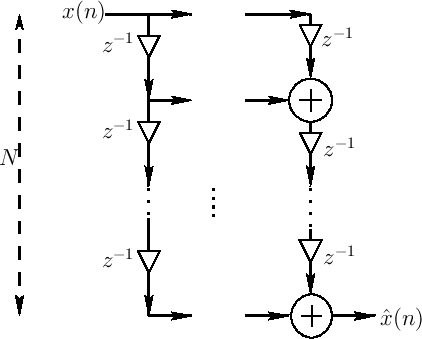When ![]() , there is no downsampling or upsampling, and
the system further reduces to the case below:
, there is no downsampling or upsampling, and
the system further reduces to the case below:

Working backward along the output delay chain, the output sum can be written as
![\begin{eqnarray*}
{\hat X}(z) &=& \left[z^{-0}z^{-(N-1)} + z^{-1}z^{-(N-2)} + z^{-2}z^{-(N-3)} + \cdots \right.\\
& & \left. + z^{-(N-2)}z^{-1} + z^{-0}z^{-(N-1)} \right] X(z)\\
&=& N z^{-(N-1)} X(z)
\end{eqnarray*}](img254.png)
Thus, when ![]() , the output is
, the output is
and we again have perfect reconstruction.